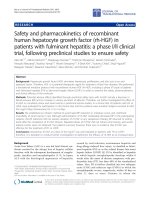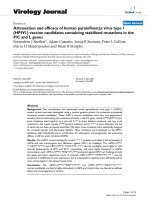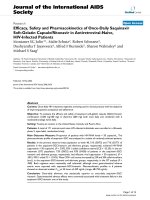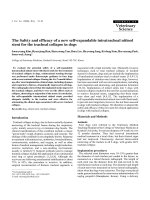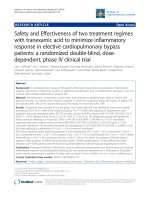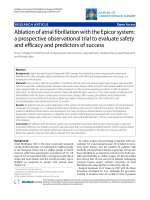Safety and efficacy of lobaplatin combined with 5-fluorouracil as first-line induction chemotherapy followed by lobaplatinradiotherapy in locally advanced nasopharyngeal carcinoma:
Bạn đang xem bản rút gọn của tài liệu. Xem và tải ngay bản đầy đủ của tài liệu tại đây (574.19 KB, 9 trang )
Ke et al. BMC Cancer (2017) 17:134
DOI 10.1186/s12885-017-3080-4
RESEARCH ARTICLE
Open Access
Safety and efficacy of lobaplatin combined
with 5-fluorouracil as first-line induction
chemotherapy followed by lobaplatinradiotherapy in locally advanced
nasopharyngeal carcinoma: preliminary
results of a prospective phase II trial
Liang-Ru Ke1,2†, Wei-Xiong Xia1,2†, Wen-Ze Qiu1,2, Xin-Jun Huang1,2, Jing Yang1,2, Ya-Hui Yu1,2, Hu Liang1,2,
Guo-Ying Liu1,2, Yan-Fang Ye1,2, Yan-Qun Xiang1,2*, Xiang Guo1,2* and Xing Lv1,2*
Abstract
Background: Due to improvements in imaging and radiological techniques as well as the use of chemotherapy,
distant metastasis has become the predominant mode of treatment failure in patients with locally advanced
nasopharyngeal carcinoma (LA-NPC). Platinum-based systemic chemotherapy has shown survival benefits and is
now the standard strategy for systemic therapy in patients with LA-NPC. Notably, the third-generation platinum
reagent lobaplatin has shown anti-tumor effects in several solid tumors with lower incidences of gastrointestinal,
hepatic and renal toxicity relative to other platinum drugs. However, the safety and efficacy of lobaplatin as a
first-line regimen in patients with LA-NPC are undetermined.
Methods: Patients with stage III–IVa-b NPC received lobaplatin at a dose of 30 mg/m2 on days 1 and 22 combined
with a continuous 120-h intravenous injection of 5-fluorouracil at a dose of 4 g/m2 followed by lobaplatin at a
dose of 50 mg/m2 on days 43 and 64 concomitant with intensity-modulated radiation therapy. Objective response
rates and acute toxicity were assessed based on RECIST (1.1) and CTCAE v.3.0, respectively. Kaplan-Meier analysis
was used to calculate survival rates.
Results: Fifty-nine patients were enrolled, and 44 patients (74.6%) received allocated cycles of chemotherapy.
The objective response rates were 88.1% (95% confidence interval [CI], 0.77 to 0.95) and 100% after induction
chemotherapy (ICT) and concurrent chemoradiotherapy (CRT), respectively. With a median follow-up period of
44 months, the 3-year estimated progression-free survival and overall survival were 86.4% (95% CI, 69.8 to 98.8)
and 94.9% (95% CI, 89.5 to 100), respectively. The most common grade 3–4 toxicities were neutropenia (8.5%)
and thrombocytopenia (40.7%) after ICT and CRT, respectively.
(Continued on next page)
* Correspondence: ; ;
†
Equal contributors
1
Department of Nasopharyngeal Carcinoma, Sun Yat-Sen University Cancer
Center, 651 Dongfeng Road East, Guangzhou, Guangdong 510060, China
Full list of author information is available at the end of the article
© The Author(s). 2017 Open Access This article is distributed under the terms of the Creative Commons Attribution 4.0
International License ( which permits unrestricted use, distribution, and
reproduction in any medium, provided you give appropriate credit to the original author(s) and the source, provide a link to
the Creative Commons license, and indicate if changes were made. The Creative Commons Public Domain Dedication waiver
( applies to the data made available in this article, unless otherwise stated.
Ke et al. BMC Cancer (2017) 17:134
Page 2 of 9
(Continued from previous page)
Conclusion: Lobaplatin combined with 5-fluorouracil followed by lobaplatin-RT treatment showed encouraging
anti-tumor effects with tolerable toxicities in patients with LA-NPC. Randomized controlled trials of lobaplatin in
patients with LA-NPC are warranted.
Trial registration: This trial was registered with the Chinese Clinical Trials Registry and approved on March 31st,
2012, number ChiCTR-ONC-12002060.
Keywords: Lobaplatin, Nasopharyngeal carcinoma, Locally advanced, First-line, Chemotherapy
Background
Nasopharyngeal carcinoma (NPC), a malignancy derived
from epithelial cells of the nasopharynx, is endemic in
Southern China and Southeast Asia [1]. The development of high-resolution imaging and radiological techniques has increased the local control rate of NPC up to
95% [2], leaving distant metastasis as the major cause of
treatment failure. To address this issue, a combined regimen of chemotherapy and radiotherapy has been recommended as the standard treatment strategy for locally
advanced NPC (LA-NPC) [3]. However, the survival
benefits of sequential chemotherapy for NPC patients
are still controversial [4–8]. Induction chemotherapy
(ICT) can improve both progression-free survival (PFS)
and/or overall survival (OS) [8–14]. Ma J et al recently
demonstrated that the introduction of cisplatin, fluorouracil, and docetaxel (TPF) induction chemotherapy to
concurrent chemotherapy could significantly improve
the PFS of patients with LA-NPC [15], while additional
randomized controlled clinical trials to determine the
role of systemic chemotherapy in NPC during the intensity modulation radiotherapy (IMRT) era are still
underway.
A platinum-based regimen is recommended as the
first-line chemotherapeutic strategy for NPC according to the NCCN guidelines. Cisplatin, the first anticancer reagent, has shown encouraging anti-tumor
efficacy in NPC both alone and in combination with
other treatments [3, 5, 16, 17]. However, cisplatin can
induce severe side effects, including dose-limiting
nephrotoxicity, cumulative peripheral sensory neuropathy, ototoxicity and gastrointestinal reactions, such
as nausea or vomiting, which can reduce patient compliance for chemotherapy administration or even
cause treatment interruptions [18]. Moreover, the requirement of a massive fluid infusion of cisplatin to
avoid renal toxicity extends the inpatient period and
limits the application of this treatment in patients
with heart and renal dysfunction. Lobaplatin, a thirdgeneration platinum reagent, forms DNA adducts and
induces DNA damage, resulting in cell apoptosis,
which is similar to the pharmacological mechanisms
of other platinum reagents [19]. Lobaplatin has shown
robust anti-tumor efficacy in multiple solid tumors,
such as breast cancer, hepatocellular carcinoma, nonsmall cell lung cancer, transitional cell carcinoma, ovarian
cancer and cervical squamous carcinoma [20–23], but
without the above-listed toxicities. Moreover, lobaplatin
has no multidrug resistance with other platinum drugs,
such as cisplatin or carboplatinum [20]. Though lobaplatin
costs approximately 16-fold more than cisplatin, there is
no increased economic burden to patients due to the high
insurance coverage of both reagents. Major characteristics
of cisplatin and lobaplatin are compared in Table 1.
A combination of lobaplatin and docetaxel has exhibited particularly effective anti-tumor activity in recurrent
and metastatic NPC [24]. Herein, to further determine
the anti-tumor efficacy of lobaplatin in LA-NPC, we performed a phase II clinical trial to determine the safety
and efficacy of lobaplatin combined with 5-fluorouracil
(5-FU) as a first-line ICT strategy followed by lobaplatinradiotherapy (lobaplatin-RT) in LA-NPC.
Methods
Aim of study and end points
The main purpose of this trial was to test the feasibility
and efficacy of delivering lobaplatin combined with 5-FU
as a first-line ICT regimen followed by lobaplatin-RT in
patients with LA-NPC. The primary end point was the
objective response rate (ORR), and secondary end points
included overall survival (OS), progression-free survival
(PFS), distant metastasis-free survival (DMFS) and local
recurrence-free survival (LRFS). Acute toxicities during
ICT and lobaplatin-RT were also observed. The study was
designed as a single arm, open-labeled phase II study.
Participant enrollment and characteristics
Regular evaluations were performed for all enrolled participants as previously described [2]. These included
medical history, physical examination, pathology diagnosis, electrocardiogram, and laboratory testing, including
but not limited to liver and kidney function and Epstein
Barr virus (EBV) DNA copy number assessment. To ensure tumor margins were well-defined, magnetic resonance imaging (MRI) of the nasopharynx and neck were
conducted in all patients, except those with contraindications (e.g., pacemaker or stent); for these cases, computed tomography (CT) was used. Regular work-ups
Ke et al. BMC Cancer (2017) 17:134
Page 3 of 9
Table 1 Comparison of cisplatin and lobaplatin
Category
Cisplatin
Lobaplatin
Product generation
First generation
Third generation
Chemical structure
Anti-tumor mechanism
Forms DNA-drug adducts, resulting in DNA damage and cell apoptosis
Half-life period
Over 24 h (total platinum) [33], mainly metabolized
through the kidney
131 ± 15 min (free platinum) and 6.8 ± 4.3 days (total platinum)
[19], mainly metabolized through the kidney
Anti-tumor spectrum
Ovarian, testicular, bladder, colorectal, lung, head and
neck cancer
Metastatic breast cancer, chronic myelogenous leukemia, and
small cell lung cancer
Side effects
Nephrotoxicity, cumulative peripheral sensory
neuropathy, ototoxicity, nausea and vomiting
Thrombocytopenia
Additional medication
Hydration for high dose
No
Solvent
Normal saline or glucose
Glucose
Drug resistance
Easy to produce
Rare and no cross-resistance with cisplatin
Expense per cycle for
platinum drugs
¥160.0-200.0 ($23.8-29.8)
¥2800.0-3400.0 ($417.9-507.5)
including chest X-rays, abdominal sonography and bone
scans, or positron emission tomography/computed tomography (PET/CT) as an optional substitution to evaluate distant metastases, were also performed based on
patient preference and financial capacity. The patients
were staged according to the American Joint Committee
on Cancer (AJCC, 7th edition) staging system based on
the above imaging results.
The following inclusion criteria were applied for enrollment: untreated patients aged 18 to 60 years; stage III or
IVa-b disease; histopathologically confirmed WHO type II
or III NPC; leukocytes ≥ 4.0X10E9; neutrophils ≥
1.5X10E9; platelets ≥ 100X10E9; hemoglobin ≥ 90 g/L;
aminotransferase ≤ 2XUNL; serum creatinine ≤ 1.5XUNL;
and no evidence of dysfunction in important organs (e.g.,
heart, lung, liver and kidney) or other malignancies. All
participants provided informed consent. Patients who
were known or suspected to be allergic to cisplatin, who
had uncontrolled infection or a physical disease that could
not tolerate chemotherapy/radiotherapy, or who could not
coordinate contact for follow-up were excluded. Additionally, pregnant females or patients who underwent immune
repressive treatment such as that following organ
transplantation were also not admitted. Patients who
could not tolerate the treatment toxicities or failed
to receive planned treatment due to voluntary refusal
or a physician’s decision were withdrawn from the
study.
From April 1, 2012 to Oct 31, 2012, 59 patients with
confirmed undifferentiated nonkeratinizing NPC were
enrolled in this study. Their demographic and clinical
characteristics before treatment are listed in Table 2.
The median age of the participants was 43 years. Fortythree (72.9%) males and 16 (27.1%) females were
enrolled. Twenty-two participants (37.3%) had a high
serum EBV DNA copy number (>4000 copies/ml) before
treatment. Twenty-nine (49.2%) participants with stage
III disease and 30 (50.8%) participants with stage IVa-b
disease were enrolled.
Treatment
Allocated treatments including two cycles of ICT
followed by two cycles of concomitant chemotherapy
and radical intensity-modulated radiotherapy (IMRT) to
the nasopharynx and neck were delivered to all patients.
The ICT consisted of 30 mg/m2 lobaplatin (intravenous
infusion, day 1) and 4 g/m2 5-fluorouracil (continuous
120-h intravenous injection) during each cycle. The concurrent chemotherapy consisted of 50 mg/m2 lobaplatin
(intravenous infusion, day 1) during each cycle. The
interval of cycles was 3 weeks.
Radical IMRT was initiated on the same day as first
concomitant chemotherapy. RT prescription doses of
68–70 Gy, 62–68 Gy and 54–60 Gy were delivered to
the planning target volume (PTV) of the primary nasopharynx tumor, involved cervical lymph nodes and
lymph node-negative areas, respectively. All patients received a regular fraction during RT, five fractions per
week and 30–33 fractions in total.
National Cancer Institute (NCI) Common Toxicity
Criteria (CTC) V.3.0 were used to determine acute
adverse events. The prescription dose of chemotherapy was modified based on the toxicity induced by
the previous chemotherapy cycle and was decreased
to 75% of the allocated dose when a patient suffered
from any of the following toxicities: granulocytopenia
fever, platelet count ≤ 25,000/μL, or grade 3 nausea
and/or
vomiting. The prescription dose of
Ke et al. BMC Cancer (2017) 17:134
Page 4 of 9
Table 2 Distribution of patient demographics and clinical
characteristics before treatment
Characteristics
Patients
No.
%
Of the 59 participants, 44 (74.6%) completed all cycles
of planned chemotherapy, 11 (18.6%) received three
cycles of chemotherapy, and four (6.8%) received only
two cycles of chemotherapy (Fig. 1).
Age, years
Median
43
Range
19-59
Assessment of efficacy and follow-up
Sex
Male
43
72.9
Female
16
27.1
59
100.0
Low (≤4000 copies/ml)
32
54.2
High (>4000 copies/ml)
22
37.3
NA
5
8.5
4
6.8
Histology, WHO typea
III
EBV DNA copy no. (pre-treatment)
b
T stage
2
3
30
50.8
4
25
42.4
0
3
5.1
1
26
44.1
2
23
39.0
3
7
11.9
N stageb
Clinical stageb,c
III
29
49.2
IVa
23
39.0
IVb
7
11.9
ECOG score
0
3
5.1
1
56
94.9
Efficacy was assessed after two cycles of ICT, after concurrent chemoradiotherapy (CRT) and 3 months after
CRT. Treatment response was evaluated based on
Response Evaluation Criteria In Solid Tumors (RECIST
1.1). The follow-up frequency for the first 2 years and
the 3rd to 5th years was 3 and 6 months, respectively.
Regular examinations including physical examinations,
indirect nasopharyngoscopy, fiber nasopharyngoscopy,
and MRI of the nasopharynx and neck were used for
efficacy evaluation and follow-up. Patients with confirmed local recurrence (LR) were diagnosed via MRI
and biopsy. Diagnosis of distant metastasis (DM) was
confirmed by a regular workup, including CT, MRI,
bone scan or PET/CT, and needle biopsy when available.
Salvage treatments including re-irradiation, surgery and/
or ablation to local lesion and/or systemic chemotherapy
were performed in patients with LR or DM as long as
they had the indications.
Statistical analysis
SPSS 22.0 (SPSS, Chicago, IL) was used to perform all
analyses in this study. A Simon Two-Stages Design was
used to determine the sample size. We assumed the
ORR to be 80%, and less than 60% was unacceptable.
The estimated rate of loss to follow-up was 10%. We set
the power to detect the effectiveness of the treatment
strategy in our study as 0.9 with a two-sided significance
of P = 0.05. Accordingly, a total of 59 evaluable patients
were required. OS, PFS, LRFS and DMFS were calculated using Kaplan-Meier analysis. All time-to-event end
Abbreviation ECOG Eastern Cooperative Oncology Group; NA not available
a
III, undifferentiated nonkeratinizing carcinoma
b
According to the 7th edition AJCC staging system
c
III, T3N0-2 M0, T1-2N2M0; IVa, T4N0-2 M0; IVb, T1-4N3M0
chemotherapy was decreased to 50% of the planned
dose when a patient developed any of the following
toxicities: grade 4 or greater nausea and/or vomiting
or creatinine clearance around 35–49 ml/min.
Prophylactic administration of hematopoietic colonystimulating factor was performed on days 3–8 of the
next chemotherapy cycle in the patients who developed grade 4 granulocytopenia. Chemotherapy was
interrupted when patients developed grade 4
hematological, hepatic or kidney toxicity and was
administered again if the toxicity decreased to grade
2 or less. Chemotherapy was no longer delivered to
patients with a remitted time of over 2 weeks.
Fig. 1 Flowchart of the trial
Ke et al. BMC Cancer (2017) 17:134
Page 5 of 9
points were calculated from the first date of treatment to the date of treatment failure or the last day
of follow-up. Patients who developed either DM or
LR were followed up until death or until the last
scheduled day of follow-up. All efficacy analyses were
performed in the intention-to-treat population. All
patients who received at least one cycle of chemotherapy were included in the toxicity analysis. This
trial was registered with the Chinese Clinical Trials
Registry, number ChiCTR-ONC-12002060.
multiple organs (n = 2). Three (5.1%) patients with
DM died of cancer progression, and the OS time
ranged from 1 to 15 months.
The 3-year estimated survival rates and the 95%
confidence intervals (CIs) for all time-to-event end
points are listed in Table 4. Kaplan-Meier survival
curves for OS or PFS and DMFS or LRFS are shown
in Figs. 2 and 3. The median of all time-to-event end
points had not been reached until after the paper was
published.
Results
Acute adverse events
Assessment of treatment efficacy
During the ICT, the following grade 3–4 acute adverse
events occurred in descending order: neutropenia (n = 5,
8.5%), leucopenia (n = 4, 6.8%), thrombocytopenia (n = 3,
5.1%), hepatotoxicity (n = 2, 3.4%) and stomatitis (n = 1,
1.7%). Likewise, during the CRT, the main grade 3–4
acute adverse events included thrombocytopenia (n = 24,
40.7%), leucopenia (n = 20, 33.9%), neutropenia (n = 15,
25.4%), anemia (n = 10, 16.9%), stomatitis (n = 2, 3.4%)
and hepatotoxicity (n = 2, 3.4%). One (1.7%) and two
(3.4%) patients developed grade 4 neutropenia during
ICT and CRT, respectively. Eight (13.6%) patients developed grade 4 thrombocytopenia after the complete treatment course (Table 5). The duration time of grade 3–4
thrombocytopenia is also listed in Table 5. In addition,
among the 15 patients who received only two or three
cycles of chemotherapy, chemotherapy was interrupted in
12 and three patients due to persistent thrombocytopenia
or leucopenia, respectively, although hematopoietic
colony-stimulating factor was administered once myelosuppression occurred.
Fifty-two (88.1%) participants experienced an objective
response (OR) after two cycles of ICT, with eight
(13.6%) and 44 (74.6%) participants experiencing a
complete response (CR) and a partial response (PR), respectively. After a complete course of treatment, all
(100%) patients experienced an OR, with 47 (79.7%) and
12 (20.3%) participants experiencing a CR and PR, respectively. Of these 12 participants, seven and four individuals experienced residual disease in the cervical
lymph nodes or nasopharynx. One patient had persistent
disease in both sites after CRT. Three months after CRT,
51 (86.4%) and two (3.4%) patients experienced CR and
PR, respectively, with six patients being lost to follow-up
at this time (Table 3). Of the two patients who experienced PR 3 months after CRT, one had residual disease
in the nasopharynx and experienced CR 6 months after
CRT and the other had persistent and stable disease in
the cervical lymph nodes during the close follow-up.
Failure patterns
Over a median follow-up time of 44 months (range
from 1 to 47 months), eight (13.6%) patients experienced disease progression, with a range of progression
time of 11 to 31 months. Of these patients, two
(3.4%) developed local relapse, one in the nasopharynx and the other in the cervical lymph nodes. Moreover, six (10.2%) patients developed DM. The sites of
DM were the liver (n = 1), the lung (n = 3) and
Table 3 Treatment responses in 59 patients
Treatment response
After two
After CRT
cycles of ICT No. (%)
No. (%)
Three months
after CRT
No. (%)
Complete response (CR)
8/59(13.6)
47/59(79.7) 51/59(86.4)
Partial response (PR)
44/59(74.6)
12/59(20.3) 2/59(3.4)
Stable disease (SD)
4/59(6.8)
0/59(0)
0/59(0)
Not available
3/59(5.1)
Discussion
Presently, concurrent chemotherapy with or without
ICT is the standard treatment strategy for patients
with LA-NPC [25]. Although the survival benefits of
ICT have been inconsistent across prior studies, ICT
can theoretically shrink local regional tumors and
eradicate micrometastases, resulting in reduced RT
volume, decreased RT dose needed for organs at risk
and a slower rate of DM. Moreover, a prior study
showed that changing from adjuvant cisplatin and 5fluorouracil to induction cisplatin and capecitabine
caused a favorable trend of increasing efficacy with
Table 4 Three-year estimates of time-to-event end points
End point
3-Year estimate (%)
95% Confidence
interval
0/59(0)
6/59(10.2)
Progression-free survival
83.0
(69.8, 98.8)
Objective response (CR + PR) 52/59(88.1)
59/59(100)
53/59(89.8)
Overall survival
94.9
(89.5, 100)
95% CI of ORR
NA
(0.82, 0.98)
Local recurrence-free survival
96.6
(92.1, 100)
Distant metastasis-free survival
89.8
(82.4, 97.9)
(0.77, 0.95)
Abbreviation ICT induction chemotherapy; CRT concurrent chemoradiotherapy;
CI confidence interval; ORR objective response rate; NA not available
Ke et al. BMC Cancer (2017) 17:134
Fig. 2 Overall survival (OS) and progression-free survival (PFS) rates
in patients with locally advanced nasopharyngeal carcinoma treated
with lobaplatin-fluorouracil followed by lobaplatin-radiotherapy
less toxicity in LA-NPC [8]. Similarly, several phase
II/III studies have shown encouraging outcomes following ICT in patients with LA-NPC [5, 8, 14, 15,
26, 27]. Platinum drugs are the most widely used
agent for both ICT and CRT in patients with NPC.
Lobaplatin is a third-generation platinum agent that
shows less gastrointestinal, auricular, liver and renal
toxicity than cisplatin or carboplatin [18]. Lobaplatin
combined with or without other reagents has shown
encouraging or equivalent anti-tumor efficacy but
with less toxicity in squamous cell carcinoma than
cisplatin [23, 28, 29]. Notably, lobaplatin combined
Fig. 3 Distant metastasis-free survival (DMFS) and local
recurrence-free survival (LRFS) rates in patients with locally
advanced nasopharyngeal carcinoma treated with lobaplatinfluorouracil followed by lobaplatin-radiotherapy
Page 6 of 9
with docetaxel also showed anti-tumor effects in recurrent or metastatic NPC [24, 30]. However, as the
anti-tumor efficacy of lobaplatin as a first-line strategy
in LA-NPC was not determined, we conducted the
current prospective phase II clinical trial.
In previous studies, ORRs following the addition of
different ICT regimens with and without CRT in LANPC were 79.4–90.0% and 85.3–100%, respectively,
after ICT and a full course of treatment [5, 8, 17,
26]. In the present study, the ORR was encouraging
after two cycles of ICT and CRT compared with a
previous study in which patients with LA-NPC
received cisplatin-5-fluorouracil ICT followed by
cisplatin-radiotherapy (88.1% vs. 79.4%, 100% vs.
85.3%, respectively) [31]. Moreover, the 3-year OS
and PFS rates of our study are also comparable with
previous studies (94.9% vs. 80.0–95.0% and 86.4% vs.
54.0–89.9%) [5, 8, 17, 26, 31]. Although there is a
bias in comparing our study with previous reports,
we were able to estimate lobaplatin’s activity as a
first-line reagent in LA-NPC. However, randomized
controlled studies are needed to compare the efficacy
of lobaplatin and other reagents as a first-line
systemic treatment for LA-NPC.
In this study, 74.6% of the patients received allocated cycles of chemotherapy, and the remaining
participants received two or three cycles of chemotherapy mainly as a result of grade 3–4
thrombocytopenia, which has been reported as the
major dose-limiting toxicity of lobaplatin [20]. Similarly, thrombocytopenia was also the most frequent
grade 3–4 toxicity in our study. However, both
thrombocytopenia and other hematological toxicities
could be cured using hematopoietic colonystimulating factor, which was acceptable. No grade 3
or 4 nausea or vomiting was observed in our study,
and the rate of this complication appeared to be
much lower than that following cisplatin-5fluorouracil ICT treatment (0% vs. 23.5%) [31]. As
lobaplatin has no or limited renal toxicity, a highvolume fluid infusion is not required during chemotherapy, which could shorten the inpatient period
and improve patient compliance. Moreover, the lack
of requirement for fluid infusion would allow patients with renal or cardiac dysfunction to receive
this treatment, thus expanding the potential population with LA-NPC who could benefit from systemic
chemotherapy.
A main limitation of this study is that it was not
blinded. Neither the investigators nor the patients
were blinded, which might have introduced observation bias from the investigators and psychological
bias from the patients. Moreover, it was a single-arm
trial from a single institution; therefore, the
Ke et al. BMC Cancer (2017) 17:134
Page 7 of 9
Table 5 Acute adverse events in 59 patients
Adverse events
No. (%) of patients by toxicity grade during ICT
No. (%) of patients by toxicity grade during CRT
1
2
3
4
1
2
3
4
Anemia
28(47.5)
4(6.8)
0(0)
0(0)
22(37.3)
13(22.0)
10(16.9)
0(0)
Neutropenia
17(28.8)
17(28.8)
4(6.8)
1(1.7)
13(22.0)
22(37.3)
13(22.0)
2(3.4)
Leucopenia
20(33.9)
14(23.7)
4(6.8)
0(0)
14(23.7)
20(33.9)
20(33.9)
0(0)
Thrombocytopenia
9(15.3)
10(16.9)
3(5.1)
0(0)
4(6.8)
20(33.9)
16(27.1)
8(13.6)
≤7
8-14
≥15
17(28.8)
6(10.2)
1(1.7)
Hematological
Days of grade 3 or greater thrombocytopenia
Non-hematological
Allergy
0(0)
0(0)
0(0)
0(0)
0(0)
0(0)
0(0)
0(0)
Weight loss
5(8.5)
0(0)
0(0)
0(0)
33(55.9)
5(8.5)
0(0)
0(0)
Stomatitis (mucositis)
2(3.4)
1(1.7)
1(1.7)
0(0)
49(83.1)
8(13.6)
2(3.4)
0(0)
Nausea
21(35.6)
2(3.4)
0(0)
0(0)
14(23.7)
6(10.2)
0(0)
0(0)
Vomiting
9(15.3)
2(3.4)
0(0)
0(0)
7(11.9)
6(10.2)
0(0)
0(0)
Diarrhea
1(1.7)
0(0)
0(0)
0(0)
1(1.7)
0(0)
0(0)
0(0)
Hepatotoxicity
21(35.6)
3(5.1)
2(3.4)
0(0)
23(39.0)
3(5.1)
2(3.4)
0(0)
Nephrotoxicity
10(16.9)
0(0)
0(0)
0(0)
11(18.6)
0(0)
0(0)
0(0)
Cardiotoxicity
0(0)
0(0)
0(0)
0(0)
0(0)
0(0)
0(0)
0(0)
Ototoxicity
0(0)
0(0)
0(0)
0(0)
10(16.9)
0(0)
0(0)
0(0)
Neurotoxicity
0(0)
0(0)
0(0)
0(0)
0(0)
0(0)
0(0)
0(0)
Joint and muscular ache
0(0)
0(0)
0(0)
0(0)
0(0)
0(0)
0(0)
0(0)
Alopecia
1(1.7)
0(0)
0(0)
0(0)
59(100)
0(0)
0(0)
0(0)
Abbreviation ICT induction chemotherapy; CRT concurrent chemoradiotherapy
superiority of lobaplatin over other platinum reagents
for treatment of LA-NPC could not be defined, and
the efficacy of lobaplatin in other non-endemic areas
is also needed. Additionally, six patients were lost to
follow-up by 3 months after treatment, leaving the
lost-to-follow-up rate (about 10%) higher than in
similar studies [7, 32], which might have resulted in
bias when forming conclusions. Additionally, longterm follow-up is required to document the longterm efficacy and late toxicities of lobaplatin in
patients with LA-NPC.
Altogether, lobaplatin showed promising anti-tumor
activity with tolerable toxicity when used as a firstline treatment strategy in patients with LA-NPC;
however, it might not be the best choice for patients
with a low reserve of bone marrow, such as patients
over 60 years old. Moreover, lobaplatin has no crossover drug resistance with other platinum reagents
[18] and therefore can be used as a substitute in
patients resistant to other platinum-based agents.
However, further randomized controlled trials are
needed to determine the anti-tumor efficacy of lobaplatin compared with other chemotherapeutic
reagents in patients with LA-NPC and to help define
the best subpopulation that will achieve maximum
survival benefits with this drug.
Conclusions
We reported the short-term results produced by administering lobaplatin-5-fluorouracil ICT followed by
lobaplatin-RT in patients with LA-NPC. A multi-center
phase III randomized controlled trial is currently being
undertaken by our group and collaborators to determine
the efficacy of lobaplatin-5-fluorouracil followed by
lobaplatin-RT vs. cisplatin-5-fluorouracil followed by
cisplatin-RT in patients with LA-NPC. At the time of
this writing, the patients in this trial were still undergoing follow-up.
Abbreviations
CI: Confidence interval; CRT: Concurrent chemoradiotherapy; DM: Distant
metastasis; DMFS: Distant metastasis-free survival; ICT: Induction
chemotherapy; LA-NPC: Locally advanced NPC; LR: Local recurrence;
LRFS: Local recurrence-free survival; NPC: Nasopharyngeal carcinoma;
ORR: Objective response rate; OS: Overall survival; PFS: Progression-free
survival; RT: Radiotherapy
Acknowledgements
We thank all the participants for their participation in the study and for their
cooperation during follow-up.
Ke et al. BMC Cancer (2017) 17:134
Funding
This trial was supported by grants from the National Nature Science
Foundation of China [81572665, 81172041, 81472525], the International
Cooperation Project of Science and Technology Plan of Guangdong Province
[2014A050503033, 2016A050502011], the Science and Technology Plan
Project of Guangdong Province [2013B021800141] and the Foundation of
Science and Technology Bureau of Guangzhou City [2014Y2-00179]. The first
five funders supported the design of the study and data collection. The
latter two funders supported data analysis and manuscript writing.
Page 8 of 9
6.
7.
Availability of data and materials
The datasets collected and analyzed during the current study are available
from the corresponding authors on reasonable request, but no information
infringing on the privacy of the participants will be given.
Authors’ contributions
XL, XG, and YX designed the study; WQ, XH, JY, YY, GL and HL collected the
data; LK, YY and WX analyzed and interpreted the data; and LK prepared the
manuscript. All authors read, revised and approved the final manuscript.
Authors’ information
Detailed information for the authors can be found on the title page.
Competing interests
The authors declare that they have no competing interests.
8.
9.
10.
Consent for publication
Not applicable.
Ethics approval and consent to participate
This study was approved by the institutional ethics board of Sun Yat-sen
University Cancer Center (SYSUCC), and all patients provided written
informed consent.
11.
Author details
1
Department of Nasopharyngeal Carcinoma, Sun Yat-Sen University Cancer
Center, 651 Dongfeng Road East, Guangzhou, Guangdong 510060, China.
2
State Key Laboratory of Oncology in Southern China, Collaborative
Innovation Center for Cancer Medicine, Guangzhou, Guangdong 510060,
China.
12.
Received: 20 September 2016 Accepted: 23 January 2017
13.
References
1. Cao SM, Simons MJ, Qian CN. The prevalence and prevention of
nasopharyngeal carcinoma in China. Chin J Cancer. 2011;30:114–19.
2. Lee N, Harris J, Garden AS, Straube W, Glisson B, Xia P, Bosch W, Morrison
WH, Quivey J, Thorstad W, Jones C, Ang KK. Intensity-modulated radiation
therapy with or without chemotherapy for nasopharyngeal carcinoma:
radiation therapy oncology group phase II trial 0225. J Clin Oncol. 2009;27:
3684–90.
3. Al-Sarraf M, LeBlanc M, Giri PG, Fu KK, Cooper J, Vuong T, Forastiere
AA, Adams G, Sakr WA, Schuller DE, Ensley JF. Chemoradiotherapy
versus radiotherapy in patients with advanced nasopharyngeal cancer:
phase III randomized Intergroup study 0099. J CLIN ONCOL. 1998;16:
1310–17.
4. Lee AW, Ngan RK, Tung SY, Cheng A, Kwong DL, Lu TX, Chan AT,
Chan LL, Yiu H, Ng WT, Wong F, Yuen KT, Yau S, Cheung FY,
Chan OS, Choi H, Chappell R. Preliminary results of trial NPC-0501
evaluating the therapeutic gain by changing from concurrentadjuvant to induction-concurrent chemoradiotherapy, changing from
fluorouracil to capecitabine, and changing from conventional to
accelerated radiotherapy fractionation in patients with locoregionally
advanced nasopharyngeal carcinoma. Cancer Am Cancer Soc. 2015;
121:1328–38.
5. Kong L, Hu C, Niu X, Zhang Y, Guo Y, Tham IW, Lu JJ. Neoadjuvant
chemotherapy followed by concurrent chemoradiation for locoregionally
advanced nasopharyngeal carcinoma: interim results from 2 prospective
phase 2 clinical trials. CANCER-AM CANCER SOC. 2013;119:4111–18.
14.
15.
16.
17.
18.
Chen L, Hu CS, Chen XZ, Hu GQ, Cheng ZB, Sun Y, Li WX, Chen YY,
Xie FY, Liang SB, Chen Y, Xu TT, Li B, Long GX, Wang SY, Zheng BM,
Guo Y, Sun Y, Mao YP, Tang LL, Chen YM, Liu MZ, Ma J. Concurrent
chemoradiotherapy plus adjuvant chemotherapy versus concurrent
chemoradiotherapy alone in patients with locoregionally advanced
nasopharyngeal carcinoma: a phase 3 multicentre randomised
controlled trial. Lancet Oncol. 2012;13:163–71.
Fountzilas G, Ciuleanu E, Bobos M, Kalogera-Fountzila A, Eleftheraki AG,
Karayannopoulou G, Zaramboukas T, Nikolaou A, Markou K, Resiga L,
Dionysopoulos D, Samantas E, Athanassiou H, Misailidou D, Skarlos D,
Ciuleanu T. Induction chemotherapy followed by concomitant
radiotherapy and weekly cisplatin versus the same concomitant
chemoradiotherapy in patients with nasopharyngeal carcinoma: a
randomized phase II study conducted by the Hellenic Cooperative
Oncology Group (HeCOG) with biomarker evaluation. Ann Oncol. 2012;
23:427–35.
Hui EP, Ma BB, Leung SF, King AD, Mo F, Kam MK, Yu BK, Chiu SK, Kwan
WH, Ho R, Chan I, Ahuja AT, Zee BC, Chan AT. Randomized phase II trial of
concurrent cisplatin-radiotherapy with or without neoadjuvant docetaxel
and cisplatin in advanced nasopharyngeal carcinoma. J CLIN ONCOL. 2009;
27:242–49.
Chan AT, Teo PM, Leung TW, Leung SF, Lee WY, Yeo W, Choi PH, Johnson
PJ. A prospective randomized study of chemotherapy adjunctive to
definitive radiotherapy in advanced nasopharyngeal carcinoma. Int J Radiat
Oncol Biol Phys. 1995;33:569–77.
International NCSG: Preliminary results of a randomized trial comparing
neoadjuvant chemotherapy (cisplatin, epirubicin, bleomycin) plus
radiotherapy vs. radiotherapy alone in stage IV (≥N2, M0) undifferentiated
nasopharyngeal carcinoma: A positive effect on progression-free survival. Int
J Radiat Oncol Biol Phys. 1996;35:463–9.
Chua DT, Sham JS, Choy D, Lorvidhaya V, Sumitsawan Y, Thongprasert
S, Vootiprux V, Cheirsilpa A, Azhar T, Reksodiputro AH. Preliminary
report of the Asian-Oceanian Clinical Oncology Association randomized
trial comparing cisplatin and epirubicin followed by radiotherapy versus
radiotherapy alone in the treatment of patients with locoregionally
advanced nasopharyngeal carcinoma. Asian-Oceanian Clinical Oncology
Association Nasopharynx Cancer Study Group. CANCER-AM CANCER
SOC. 1998;83:2270–83.
Ma J, Mai HQ, Hong MH, Min HQ, Mao ZD, Cui NJ, Lu TX, Mo HY. Results of
a prospective randomized trial comparing neoadjuvant chemotherapy plus
radiotherapy with radiotherapy alone in patients with locoregionally
advanced nasopharyngeal carcinoma. J CLIN ONCOL. 2001;19:1350–57.
Chua DT, Ma J, Sham JS, Mai HQ, Choy DT, Hong MH, Lu TX, Min HQ.
Long-term survival after cisplatin-based induction chemotherapy and
radiotherapy for nasopharyngeal carcinoma: a pooled data analysis of two
phase III trials. J CLIN ONCOL. 2005;23:1118–24.
Hareyama M, Sakata K, Shirato H, Nishioka T, Nishio M, Suzuki K, Saitoh A,
Oouchi A, Fukuda S, Himi T. A prospective, randomized trial comparing
neoadjuvant chemotherapy with radiotherapy alone in patients with
advanced nasopharyngeal carcinoma. CANCER-AM CANCER SOC. 2002;94:
2217–23.
Sun Y, Li WF, Chen NY, Zhang N, Hu GQ, Xie FY, Sun Y, Chen XZ, Li JG, Zhu
XD, Hu CS, Xu XY, Chen YY, Hu WH, Guo L, Mo HY, Chen L, Mao YP, Sun R,
Ai P, Liang SB, Long GX, Zheng BM, Feng XL, Gong XC, Li L, Shen CY, Xu JY,
Guo Y, Chen YM, Zhang F, Lin L, Tang LL, Liu MZ, Ma J. Induction
chemotherapy plus concurrent chemoradiotherapy versus concurrent
chemoradiotherapy alone in locoregionally advanced nasopharyngeal
carcinoma: a phase 3, multicentre, randomised controlled trial. Lancet
Oncol. 2016;17:1509–20.
Chen Y, Sun Y, Liang SB, Zong JF, Li WF, Chen M, Chen L, Mao YP, Tang LL,
Guo Y, Lin AH, Liu MZ, Ma J. Progress report of a randomized trial
comparing long-term survival and late toxicity of concurrent
chemoradiotherapy with adjuvant chemotherapy versus radiotherapy
alone in patients with stage III to IVB nasopharyngeal carcinoma from
endemic regions of China. CANCER-AM CANCER SOC. 2013;119:2230–38.
Gu MF, Liu LZ, He LJ, Yuan WX, Zhang R, Luo GY, Xu GL, Zhang HM, Yan
CX, Li JJ. Sequential chemoradiotherapy with gemcitabine and cisplatin for
locoregionally advanced nasopharyngeal carcinoma. Int J Cancer. 2013;132:
215–23.
Dilruba S, Kalayda GV. Platinum-based drugs: past, present and future.
Cancer Chemother Pharmacol. 2016;77:1103–24.
Ke et al. BMC Cancer (2017) 17:134
19. Welink J, Boven E, Vermorken JB, Gall HE, van der Vijgh WJ.
Pharmacokinetics and pharmacodynamics of lobaplatin (D-19466) in
patients with advanced solid tumors, including patients with impaired
renal of liver function. Clin Cancer Res. 1999;5:2349–58.
20. McKeage MJ. Lobaplatin: a new antitumour platinum drug. Expert Opin
Investig Drugs. 2001;10:119–28.
21. Perabo FG, Muller SC. New agents for treatment of advanced transitional
cell carcinoma. Ann Oncol. 2007;18:835–43.
22. Li X, Li Y. Clinical study on chemotherapy of lobaplatin combined with
docetaxel in patients with relapsed ovarian cancer. Zhong Nan Da Xue Xue
Bao Yi Xue Ban. 2014;39:1131–36.
23. Li WP, Liu H, Chen L, Yao YQ, Zhao EF. A clinical comparison of lobaplatin
or cisplatin with mitomycine and vincristine in treating patients with
cervical squamous carcinoma. Asian Pac J Cancer Prev. 2015;16:4629–31.
24. Long GX, Lin JW, Liu DB, Zhou XY, Yuan XL, Hu GY, Mei Q, Hu GQ. Singlearm, multi-centre phase II study of lobaplatin combined with docetaxel for
recurrent and metastatic nasopharyngeal carcinoma patients. Oral Oncol.
2014;50:717–20.
25. Lin JC, Jan JS, Hsu CY, Liang WM, Jiang RS, Wang WY. Phase III study of
concurrent chemoradiotherapy versus radiotherapy alone for advanced
nasopharyngeal carcinoma: positive effect on overall and progression-free
survival. J CLIN ONCOL. 2003;21:631–37.
26. Airoldi M, Gabriele AM, Garzaro M, Raimondo L, Condello C, Beatrice F,
Pecorari G, Giordano C. Induction chemotherapy with cisplatin and
epirubicin followed by radiotherapy and concurrent cisplatin in locally
advanced nasopharyngeal carcinoma observed in a non-endemic
population. Radiother Oncol. 2009;92:105–10.
27. Hong RL, Ting LL, Ko JY, Hsu MM, Sheen TS, Lou PJ, Wang CC, Chung NN,
Lui LT. Induction chemotherapy with mitomycin, epirubicin, cisplatin,
fluorouracil, and leucovorin followed by radiotherapy in the treatment of
locoregionally advanced nasopharyngeal carcinoma. J CLIN ONCOL. 2001;
19:4305–13.
28. Wang JQ, Wang T, Shi F, Yang YY, Su J, Chai YL, Liu Z. A Randomized
Controlled Trial Comparing Clinical Outcomes and Toxicity of LobaplatinVersus Cisplatin-Based Concurrent Chemotherapy Plus Radiotherapy and
High-Dose-Rate Brachytherapy for FIGO Stage II and III Cervical Cancer.
Asian Pac J Cancer Prev. 2015;16:5957–61.
29. Yang JS, Wang T, Qiu MQ, Li QL. Comparison of efficacy and toxicity
profiles between paclitaxel/lobapoatin- and cisplatin/5-fluorouracil-based
concurrent chemoradiotherapy of advanced inoperable oesophageal
cancer. Intern Med J. 2015;45:757–61.
30. Zhang S, Chen J, Yang S, Lin S. An open-label, single-arm phase II clinical
study of docetaxel plus lobaplatin for Chinese patients with pulmonary and
hepatic metastasis of nasopharyngeal carcinoma. Anticancer Drugs. 2016;27:
685–88.
31. Ferrari D, Chiesa F, Codeca C, Calabrese L, Jereczek-Fossa BA, Alterio D,
Fiore J, Luciani A, Floriani I, Orecchia R, Foa P. Locoregionally advanced
nasopharyngeal carcinoma: induction chemotherapy with cisplatin and 5fluorouracil followed by radiotherapy and concurrent cisplatin: a phase II
study. Oncology Basel. 2008;74:158–66.
32. Songthong AP, Kannarunimit D, Chakkabat C, Lertbutsayanukul C. A
randomized phase II/III study of adverse events between sequential (SEQ)
versus simultaneous integrated boost (SIB) intensity modulated radiation
therapy (IMRT) in nasopharyngeal carcinoma; preliminary result on acute
adverse events. Radiat Oncol. 2015;10:166.
33. Himmelstein KJ, Patton TF, Belt RJ, Taylor S, Repta AJ, Sternson LA. Clinical
kinetics on intact cisplatin and some related species. Clin Pharmacol Ther.
1981;29:658–64.
Page 9 of 9
Submit your next manuscript to BioMed Central
and we will help you at every step:
• We accept pre-submission inquiries
• Our selector tool helps you to find the most relevant journal
• We provide round the clock customer support
• Convenient online submission
• Thorough peer review
• Inclusion in PubMed and all major indexing services
• Maximum visibility for your research
Submit your manuscript at
www.biomedcentral.com/submit

